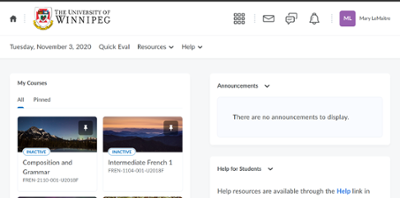Arts departments pivot to online (Part 2) - language teaching - Dr. Mary LeMaitre
Thu. Nov. 5, 2020
Since teaching has gone online, it has become two dimensional! This has its advantages and disadvantages. The big disadvantage is that you cannot interact with your students or have them interact with each other in the same way and sitting listening to someone on a screen for an hour can be hard.
 Dr. Mary LeMaître as she appears to her online students
Dr. Mary LeMaître as she appears to her online students
As I do not have a chalk board, but do use PowerPoint presentations, I do two things:
- I anticipate questions students will ask and I prepare short exercises that I would normally do on the board, and
- I try to vary screen so that students are not looking at a PowerPoint the whole time. This includes visiting sites with useful material or resources, using break-out groups, and doing group activities. Students' attention is held better when they are working as a group and they have to use their mics!
The advantage of teaching online is that you can integrate a lot more online resources to make class and homework interesting. This can include:
- sites for students to explore, online games, auto-correcting grammar exercises, and
- sites that allow you to create online games or quizzes for them.
 Dr. LeMaître's courses in Nexus
Dr. LeMaître's courses in Nexus
I like to use Kahoot. You can get it for free to create multiple choice or true or false quizzes. Game show type music plays while students are doing the quiz. And there’s a timer you can set to decide how much time you want to give students to answer each question. As well, you can add a picture to the background of each question. There are other options in terms of question types, but you must upgrade to Premium.
I am also really enjoying all the Nexus teaching options there are to discover! My favorite new section is "Assessments". It is great for giving homework and tests! The two headings under “Assessments” that I use are: (i) “Assignments” and “Quiz”.
I post homework in "Assignments". Students can access it and submit their work at any time. You can see at a glance who has submitted their homework and when. Feedback is very easily provided by highlighting parts of their work and leaving comments in the side column. The student simply resubmit the assignment with corrections.
Under "Quiz" you can make a typical test with many question styles as options. Questions can be moved around, deleted, copied, etc. as you are creating the quiz. Tip: When it asks for the percentage value of each question, divide 100 by the number of questions. The total value is entered by you at the top of the page.
One last tip I will give for teaching on line via Zoom is to try it out before using it with students. Start a meeting and check out the best angle to be teaching at in terms of light, how close you need to be to the camera, and how to transition easily between slides. Try out the white board as well if you have a stylus!
The learning curve for teaching online is very sharp at first, but it is a grand adventure!
